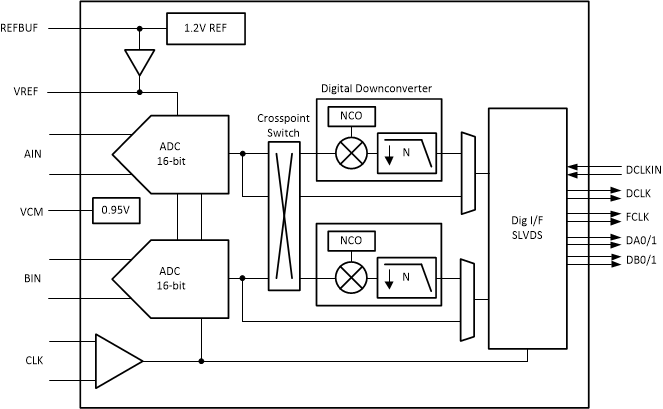SBAS991B February 2021 – September 2022 ADC3661 , ADC3662 , ADC3663
PRODUCTION DATA
- 1 Features
- 2 Applications
- 3 Description
- 4 Revision History
- 5 Pin Configuration and Functions
-
6 Specifications
- 6.1 Absolute Maximum Ratings
- 6.2 ESD Ratings
- 6.3 Recommended Operating Conditions
- 6.4 Thermal Information
- 6.5 Electrical Characteristics - Power Consumption
- 6.6 Electrical Characteristics - DC Specifications
- 6.7 Electrical Characteristics - AC Specifications
- 6.8 Timing Requirements
- 6.9 Typical Characteristics - ADC3661
- 6.10 Typical Characteristics - ADC3662
- 6.11 Typical Characteristics - ADC3663
- 7 Parameter Measurement Information
- 8 Detailed Description
- 9 Application Information Disclaimer
- 10Device and Documentation Support
- 11Mechanical, Packaging, and Orderable Information
Package Options
Mechanical Data (Package|Pins)
- RSB|40
Thermal pad, mechanical data (Package|Pins)
- RSB|40
Orderable Information
3 Description
The ADC3661, ADC3662, and ADC3663 (ADC366x) family of devices are low-noise, ultra-low power, 16-bit, 10-MSPS to 65-MSPS, high-speed, dual-channel, analog-to-digital converters (ADCs). Designed for low noise performance, these devices deliver a noise spectral density of –158 dBFS/Hz combined with great linearity and dynamic range. The ADC366x offers good dc precision together with IF sampling support making these devices suitable for a wide range of applications. High-speed control loops benefit from the short latency as low as only 1 clock cycle. The ADC consumes only 94 mW/ch at 65 MSPS and power consumption that scales well with lower sampling rates.
The ADC366x uses a serial LVDS (SLVDS) interface to output the data. The devices support a two-lane, a one-lane and a half-lane option. These devices are a pin-to-pin compatible family with 16-bit and 18-bit resolution and different speed grades. The devices come in a 40-pint QFN package (5 x 5 mm), and supports the extended industrial temperature range of –40°C to +105⁰C.
| PART NUMBER | PACKAGE(1) | BODY SIZE (NOM) |
|---|---|---|
| ADC366x | WQFN (40) | 5.00 × 5.00 mm |
| PART NUMBER | RESOLUTION | SAMPLING RATE |
|---|---|---|
| ADC3661 | 16 BIT | 10 MSPS |
| ADC3662 | 16 BIT | 25 MSPS |
| ADC3663 | 16 BIT | 65 MSPS |
| ADC3664 | 14 BIT | 125 MSPS |
 Simplified Block Diagram
Simplified Block Diagram